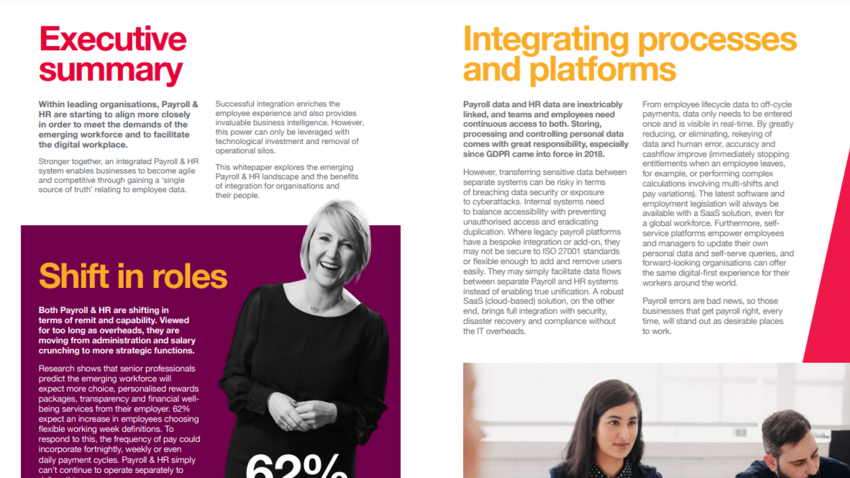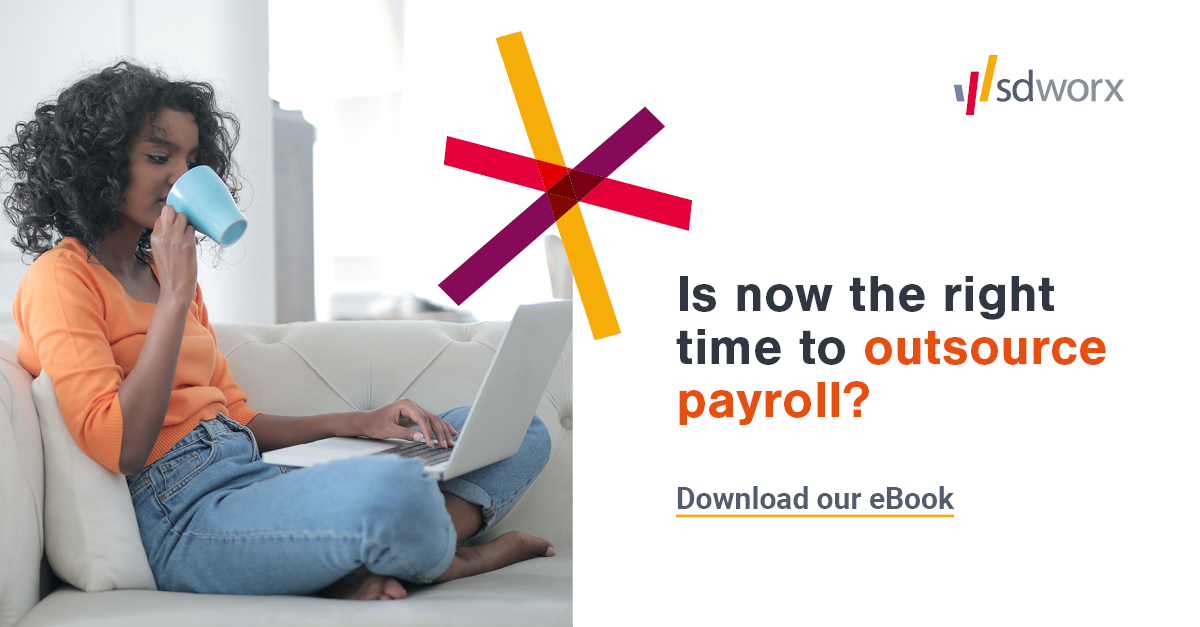
Why payroll should be in the cloud
In October 2021, SD Worx had the pleasure to host the two virtual roundtables with Heads of HR and Payroll. Taking part in the first roundtable were two experts in the field of payroll management and automation; Sue Knowles - HR Director at Costco and our own Stephen Knapman – Global Sales Manager, and in the second roundtable we were joined by Emma Thomas - UK & Ireland Payroll Lead at GSK, and Amanda 'Mandy' Hawley - Partner and Channel Sales Director UKI at SD Worx.
Whilst our conversations were wide ranging, in this article we will summarise a few of the key topics we discussed and the conclusions we reached.
The need for change
For many organisations, payroll management is a routine but critical business function that appears to ‘just happen’ in the background; and although the day-to-day operations of a stable payroll process typically run smoothly and for a long time, there inevitably comes a time when it becomes clear that it is time for a change. Here are some of the reasons that we heard during the roundtable:
- Additional functionality – several of the participants mentioned that they want to get more functionality from their payroll systems (e.g., analytics, so that they could support business planning)
- End of Life for the current system – through lack of ongoing support, or limitations to performance/interoperability with other systems (others cited the need for a more secure and resilient solution)
- Significant changes in business needs – the pandemic triggered or accelerated changes to the business that the existing payroll platforms were unable to accommodate. For example, as part of a coordinated upgrade of both payroll and HR systems
- The need to simplify or reduce cost – several of the attendees described an environment made up of multiple legacy payroll systems (usually because of M&A activity) and were complex to run, as well as costly to operate and maintain, either in terms of labour or license fees
- Flexible scaling – if your business is going through periods of growth or shrinkage, you may need a solution that can scale with you
- Major IT transformations – as part of a wider transformation agenda or change in IT strategy (e.g., moving to ‘Software as a Service’ or to the Cloud).
For GSK, the reason for change was a combination of needing to integrate with a new HR system, as well as move on from a legacy payroll solution. Whilst for Costco, it was the need to move from a long-standing legacy payroll solution to a new SaaS solution that could manage a disparate workforce across multiple international locations. Many of the attendees said that they too were faced with the challenge of running a payroll for a multinational business in a volatile environment.
Making the change
Having established the need for change, our conversation then turned to the actual process of making the change, and here Sue was able to share the benefits of her experience.
Firstly, she stressed the need to involve the users in the process from the very beginning; not just because they will be the users, but also because they have the insights into how the payroll process works on the ground. Sue also engaged the Training team early to ensure that training materials were in place in plenty of time.
Secondly, she mentioned that they had two separate threads; a senior team, who were overseeing budget and timescales (Sue was very clear about knowing what you can and cannot afford), and an operational team who were engaged in the day-to-day project and tasks. As to the team composition, Sue described a multidisciplinary team that represented Payroll, Finance, IT, Operations and Training. Also of importance is that the project team is composed of the right people and not just those who are currently available, and they are accessible after the ‘go live’ date to answer questions about the original design objectives and processes.
Steve gave SD Worx’s perspective: firstly, you must have a clear vision. You can’t tell if you have completed the journey if you don’t know the destination; spending time discussing, agreeing, and documenting the vision, and what capabilities are required to achieve it, saves time and effort during implementation. Also, lay down some ground rules (scope). For example, are you going for ‘big bang’ or a phased implementation?
Process change: Emma described how, in the design of the new solution and a review of the existing processes it became clear that they could not simply be adapted, they needed to be completely redone, especially as several the existing processes were manual and could not be automated in their current form.
Data Migration: it is critical to think about how the data is going to be transferred from the existing systems into the new one (although this is also a great opportunity to ‘clean the data’). You may also have to engage the incumbent supplier to assist with this process, so start that conversation early on.
The benefits of getting it right
Sue described some of the benefits that she achieved from making the transformation to SaaS payroll:
- A more capable solution – Costco accomplished all of what it set out to achieve; a new solution that was better suited to its business needs
- More actionable insights – not only in being able to more easily produce the number of reports that are required of the business, but also in supporting decision-making with pertinent data and insights (Emma also noted the value of enhanced reporting)
- Flexibility where needed – like many organisations, Costco has some specific ways of working and these were incorporated into the new solution too.
- Future capability – importantly for Costco was the option of deeper integration with other systems in the future, especially HR
In addition to the above, Emma added:
- Reduction in manual labour – many of the previously manual processes were automated, which was both faster and more reliable. Automation also provided task scheduling (such as monthly report generation)
- Clean Audit Trail – the new solution gave better insight into the data and process.
- Enhanced Self-service – employees could access their payroll and tax documentation directly, without having to make a request of HR or Payroll
- A Cloud-based solution – in line with other parts of the business strategy and enabled integration with other systems (e.g., the new HR system)
Making the business case
During the pandemic, a lot of transformation initiatives were approved without the need for a full business case being made; the need to move at pace (critical to business survival in some cases) outweighed the risk of making a hasty investment. However, the need to change payroll solutions rarely fell under that banner.
How to make the business case?
- Be very clear on why there is a need for change from the current state
- Ensure you are aligned with other business stakeholders and strategies (e.g., HR and IT). If your business is looking to outsource core processes, a cloud-based solution may be more attractive
- Working with Finance, calculate a return-on-investment model, with associated risks and assumptions
- Be realistic; about both the benefits and the costs (including the ‘intangibles’)
- Define your success criteria (it is from these criteria that you will define the capabilities you need of any future solution and therefore the best supplier to meet them)
Final thought
All our experts agreed that it was vital to document everything you want from the solution and your decision-making process. We would recommend taking the MoSCoW approach:
- Must have – what must the system be able to do? (i.e., what current or new functions are critical and absolutely required to ensure success)
- Should have – what highly desirable or important functions should the solution have, but are not critical to success or not immediately required?
- Could have – these are functions which are ‘nice to have’ and improve the quality of the overall solution, but should only be specified if time and budget allow
- Won’t have – these are the least critical features that are not going to be implemented (or at least, not in the foreseeable future).
And in doing so, engage with stakeholders from different parts of the business and at different levels early – especially the people who will have to operate the new system.
With that said, let’s give Steve the final word:
It is in defining requirements a partner like SD Worx can really help; most payroll teams do not have time to research all the possible features and functions that may be available from potential suppliers. SD Worx can work with you and the business to identify, prioritise, and cost the components you need to maximise your probability of success, whilst working within your budget and timescales.
Both Steve and Mandy stressed the need to form a partnership between vendor and the client. At every stage, each partner should contribute to the process, from design, through delivery, and during post-implementation support. An important part of this process is to speak to other clients of your potential supplier and determine relative strengths and their way of working. It is likely that you will work with your new partner for many years, so it pays to take some time at this stage.
If you would like to speak to someone at SD Worx about any of the points raised in this article, or discuss the future or your payroll solution, then please contact us.


